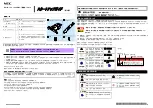
Introduction
1000BASE-T/100BASE-TX/10BASE-T Physical Layer Compliance Tests Manual
4
Intel Confidential
Figure 1-4. Best Resolution for Measurement
Note:
The above three screen shots were not necessarily taken during the same session.
Note:
The waveform in
is displayed across the entire screen, showing enough of the edge of
the pulse to allow the zero point to be approximated and providing the best resolution possible for
measurement.
In the example above, the “Average” setting was used on the scope to produce a sharper image.
This is the best (and easiest) way to measure the amplitude, period, overshoot, and rise/fall time of
a waveform. Each time a new trigger signal arrives, the scope repaints the screen with a new signal.
This causes the signal to appear unstable because each successive signal is not exactly the same as
the previous one. By averaging the waveforms together, random noise will be filtered from the
display, and a more representative signal will appear.
Some measurements require the scope display to be set to “Infinite Persistence.” In this case it is
important that each successive waveform falls within specified boundary conditions. In infinite
persistence mode, an adequate sample is obtained from data accumulated between a one to ten
minute time period.
1.3
Required Test Equipment
This section describes the minimum equipment needed to complete the test.
•
Digitizing oscilloscope with at least 1 GHz bandwidth (for example, Tektronix 784).
•
Two high bandwidth differential probes (for example, Tektronix P6247) with capacitance less
than or equal to 1 pF and a bandwidth greater than or equal to 1 GHz. Using lower bandwidth/
higher capacitance probes may cause false failures of conformance tests.















































